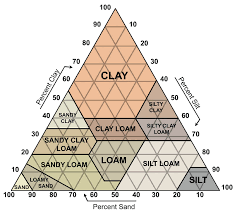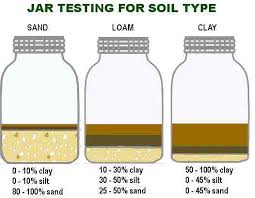Granules that are bigger than sand, are called gravel.
Sand particles are 0.05 to 2 mm in size, generally large enough to be visible. They feel between the fingers always gritty. A handful moist sand is falling apart. Sandy soils are poor soils that quickly lose nutrients and water.
Usage: liquid filters, abrasives, glass production, computer chips, and you can also use it to make sand castles.
 Loam particles, on the other hand (0.002 mm to 0.05 mm) are smaller than sand, and are no longer visible to the naked eye. Loam or silt is clotting.
Loam particles, on the other hand (0.002 mm to 0.05 mm) are smaller than sand, and are no longer visible to the naked eye. Loam or silt is clotting.
Usage: mud walls and stucco, brittle ceramics.
The finest particles of the soil (clay) are smaller than 0.002 mm. A clay layer won’t let pass water. Pure clay particles are smooth and stick to your fingers. You can rub it shiny when wet.
So in each case it is the same material, but in smaller particles.
Sand almost doesn’t weather. In clay and loam weathering releases nutrients such as potassium and magnesium. A fertile soil contains 25% air, 25% water, 45% rock grains and 5% organic matter. The structure must also be grainy. Mixed types with mainly clay are therefore most suitable for crops.
Clay gives problems because of poor ventilation and slow drainage.
Sablon (from the Latin sabulum; ”coarse sand” or ”gravel”) is a (mineral) soil, a mixture of sand and clay with a certain % lutum. Lutum are ground particles which are smaller than 2 micrometers (µm).
With a lutum percentage between 8% and 12% we speak about very light sablon,
between 12% and 17.5% of moderately light sablon,
between 17.5% and 25% of heavy loam.
In case of more than 25%, one speaks of clay. Loess is an aeolian (wind-blown) deposition of silt. Silt is ground with a grain size between those of sand and clay. It contains mainly siliciclastica (quartz and other silicates), but also a small fraction of clay minerals.
Loess is an aeolian (wind-blown) deposition of silt. Silt is ground with a grain size between those of sand and clay. It contains mainly siliciclastica (quartz and other silicates), but also a small fraction of clay minerals.
To I’s appearance loess is also called Limburg clay. (You can find it further in North China along the Yellow River, and in the Russian steppe area.) The slight sediment of the (dried) seabed was carried by the wind and formed the loess deposition. Loess soils are very suitable for agriculture.
The soil is – not as in ’modern' cultivation of corn and others- more than substrate that holds water and roots. It is a living organ, a habitat that is only alive and remains healthy through a good balance between the necessary fungi, bacteria, plants and animals. Overweight interventions (deep plowing, spraying) damage or kill the most prolific and important top layer of the earth.
One does not sell land on which people walk. (Tashunca Uitco)
Two grains of sand walking in the desert. Said one to the other:”Crowdy, hey!”
